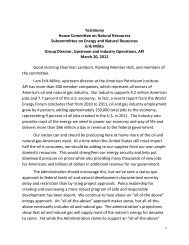timber sales in this area requires adding just 11 people to the current staff. This modestinvestment would be paid back from direct payments for the timber sold, the reduced costsof stewardship c<strong>on</strong>tracts, and the potential savings from reduced wildfire risks. <str<strong>on</strong>g>The</str<strong>on</strong>g>commitment for l<strong>on</strong>g-term access to this timber is necessary to justify the l<strong>on</strong>g-term natureof these investments and additi<strong>on</strong>al investments such as those which hold great promise forusing bio-mass from the forest for generating clean-renewable energy. But thoseinvestments are not justified without a stable, l<strong>on</strong>g-term supply of timber.2. <str<strong>on</strong>g>The</str<strong>on</strong>g> timber sales must be ec<strong>on</strong>omically viable. Viability is determined by the compositi<strong>on</strong>of the timber being sold and the performance requirement under those c<strong>on</strong>tracts.Lodgepole pine, the type of tree most widely infested, has relatively low commercial appeal,so the timber c<strong>on</strong>tracts must be written in a way that harvesting is not cost prohibitive.3. <str<strong>on</strong>g>The</str<strong>on</strong>g> industry must comply with current envir<strong>on</strong>mental regulati<strong>on</strong>s, but it needs protecti<strong>on</strong>from malicious envir<strong>on</strong>mentalist acti<strong>on</strong>s such as those that destroyed the timber industryin other parts of the country. To understand this, we need look no further than Ariz<strong>on</strong>awhere in 1996 an envir<strong>on</strong>mental group w<strong>on</strong> a court injuncti<strong>on</strong> that temporarily shut downlogging <strong>on</strong> all nati<strong>on</strong>al forests in Ariz<strong>on</strong>a and New Mexico. As a result, the Ariz<strong>on</strong>a timberindustry is now largely extinct. Since then, Ariz<strong>on</strong>a has had the five largest forest fires in itshistory. For more than a decade, that state’s government has desperately been trying withfinancial incentive and other means, to reestablish an Ariz<strong>on</strong>a timber industry but has beenunsuccessful – it simply is not ec<strong>on</strong>omically feasible to replace what was lost. In Colorado,what remains of the timber industry must be viewed as a precious resource for the state.It needs to be protected, because if the industry, and in particular if these two mills, are lost,like in Ariz<strong>on</strong>a, they will not be rebuilt.<str<strong>on</strong>g>The</str<strong>on</strong>g>re is an opportunity for the last two large sawmills in this regi<strong>on</strong>, using effective private enterprise,to aid in the near and l<strong>on</strong>g-term timber management needs of Colorado and Wyoming. For this tohappen, it is essential for the US Forest service to provide an adequate, l<strong>on</strong>g-term stable supply oftimber, under ec<strong>on</strong>omically viable terms. It is also essential that the timber industry be providedprotecti<strong>on</strong> from an unreas<strong>on</strong>able use of envir<strong>on</strong>mental regulati<strong>on</strong>s such as that which has destroyedother regi<strong>on</strong>al timber industries.Thank you for your invitati<strong>on</strong> to speak at this hearing. Your leadership is a critical comp<strong>on</strong>ent in thefuture of this industry. I would be happy to answer any questi<strong>on</strong>s.FOLLOWING IS INFORMATION SUPPORTING THE STATEMENTS ABOVE:HISTORY OF THE COLORADO TIMBER INDUSTRYA <strong>on</strong>ce vibrant industry, built up over a century, has been decimated due to the lack of access toColorado’s abundant timber resources.To understand the current crisis facing the forests in Colorado, it is helpful to review the history of theColorado timber industry. <str<strong>on</strong>g>The</str<strong>on</strong>g> Colorado timber industry began in the 1860s when vast tracts of virginforests were harvested to support mining, railroads and housing development in the state. FollowingWorld War II, with str<strong>on</strong>g housing markets and public policy encouraging timber producti<strong>on</strong> <strong>on</strong> Nati<strong>on</strong>alForests, timber harvests for industrial products in the Four Corners States increased from about 7002
milli<strong>on</strong> board feet (MMBF, Scribner log scale) annually during the early 1950s to a peak of approximately1,000 MMBF in the late 1960s.During the 1970s and 1980s, harvest volumes dropped somewhat with harvests during the late 1980saveraging about 850 MMBF annually. Timber harvests from the regi<strong>on</strong> dramatically declined during the1990s, caused largely by decreases in the harvests from Nati<strong>on</strong>al Forests caused by litigati<strong>on</strong> related tothreatened and endangered species and reduced Federal budget levels.This litigati<strong>on</strong> caused the USFS to dramatically reduce the volume of timber sold in the Colorado fromthe high in the 1960s down to an average of just 40 - 45MMBF per year from 2003-2007. <str<strong>on</strong>g>The</str<strong>on</strong>g> reducedsupply of timber could no l<strong>on</strong>ger support the needs of the timber industry and the effect in Coloradowas dramatic; two oriented strand board mills closed, <strong>on</strong>e in Olathe and the other in Kremmling; alarge sawmill in Walden closed in 1994; three of Colorado’s largest multi-nati<strong>on</strong>al mills closed in 2001and 2002; a large independently-owned mill at South Fork closed in 2001 (after 50 years of operati<strong>on</strong>);and nine other medium-sized mills and dozens of small mills have closed their doors since 1982.Unfortunately, timber management in the Colorado forests is dependent up<strong>on</strong> an active timberindustry for timber stand improvements using treatments that harvest wood products. With themajority of local mills closing, the industry has reduced capacity to harvest timber (logs can <strong>on</strong>ly beec<strong>on</strong>omically shipped short distances). C<strong>on</strong>sequently, over the years, the Colorado forests haveexperienced increased stand density and an accumulati<strong>on</strong> of ladder-fuels; c<strong>on</strong>diti<strong>on</strong>s that have directlyled to the large-scale wildfires and insect epidemics now facing the state.Today, if we do not count the two dozen very small operators with 10 or fewer employees, there arejust two medium sized and <strong>on</strong>e large operating mills in Colorado. Moreover, the large sawmill inM<strong>on</strong>trose is financially troubled and operating under receivership. A sec<strong>on</strong>d large sawmill in Saratoga,WY is well located to service the northern Colorado forests (where the heaviest c<strong>on</strong>centrati<strong>on</strong> of beetlekilled pine is located), but has been idle since 2002 when it was shut down due to a lack of logs.THE ROLE OF THE USFS IN THE COLORADO TIMBER INDUSTRY<str<strong>on</strong>g>The</str<strong>on</strong>g> United States Forest Service manages the vast majority of timber in Colorado and c<strong>on</strong>trols thedestiny of the Colorado sawmill industry.Any discussi<strong>on</strong> of the Colorado timber industry requires a discussi<strong>on</strong> of the USFS. Nearly 68 percent ofColorado's forests are in federal ownership and nearly three-quarters of the state's high-elevati<strong>on</strong>,commercially attractive species such as spruce-fir, lodgepole pine and aspen are located <strong>on</strong> USFS lands.In c<strong>on</strong>trast, the majority of the Colorado forests c<strong>on</strong>trolled by private lands are low elevati<strong>on</strong> species.3
















